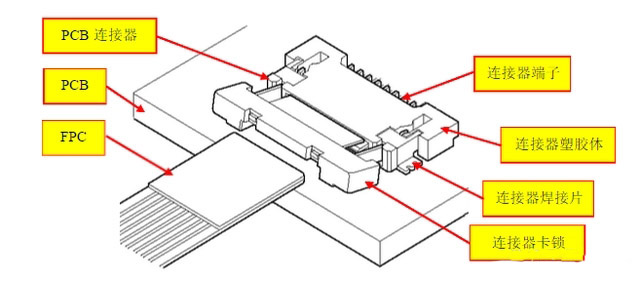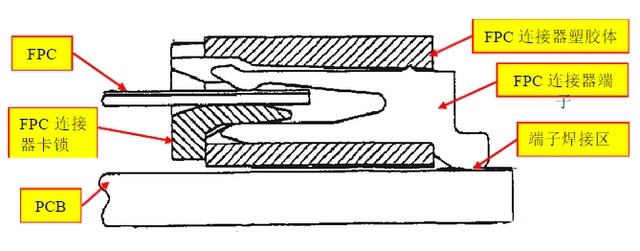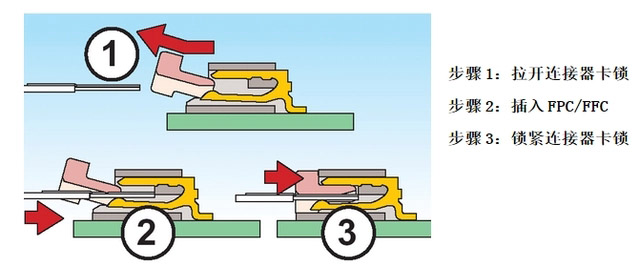Now all kinds of consumer electronic products have been miniaturized, thinned and high-performance, and the use of flexible printed circuit boards (FPC) and matching FPC connectors to reduce space, reduce weight, and reduce assembly costs has been accepted. Accepted by many customers, FPC connectors are becoming more and more popular. So, how should the FPC connector be selected? The following aspects will introduce the FPC connector to you, and I hope it will be helpful to you.
ntroduction to the structure of FPC connector
FPC connectors are used to connect printed circuit boards (PCB) and flexible printed circuit boards (FPC) to achieve mechanical and electrical connections. Its characteristic is that one end is connected with PCB welding (SMT welding is mostly used), the other end is mated with FPC, and the FPC connector is designed with a locking device to lock the FPC and FPC connector to maintain certain contact reliability. Therefore, there are strict matching requirements between the plastic body of the connector and the terminals and locking parts. As shown in the figure below, it is a product schematic diagram of the FPC connector:

In order to meet the requirements of the SMT process, the terminal welding area of the entire product is strictly required to have good flatness and coplanarity. Usually the industry standard is coplanarity 0.10max. Otherwise, it will lead to poor soldering with the PCB and affect the quality of the product. use
plastic body
The inside of the plastic body is an equidistant sheet-like barrier structure, which keeps the terminals arranged at a small distance and provides a certain holding force after assembly. According to the use requirements of the product, the plastic body must have sufficient strength and toughness, and there must be no warping deformation before and after SMT welding.

terminal
The terminal is the contact part of the FPC connector. In order to achieve high-density arrangement of the connector and more stable contact performance, the FPC connector terminal adopts a narrow-piece contact method, and the material is made of phosphor bronze with good electrical conductivity and mechanical strength.
Usually, there are two ways to design the terminal structure, one is punching flat blanking terminal (abbreviation: blanking terminal), and the other is bending and forming terminal after stamping (abbreviation: formed terminal). Since the narrow piece female terminal needs to have sufficient elasticity and a relatively complex shape, if it is formed by stamping, it will cause difficulties in the stamping process, and the forming size and precision are not easy to control. So usually the female terminal adopts the forming method.
Since the application feature of the FPC connector is to be mated with the straight sheet FFC (flexible printed circuit board/flat cable), the terminals are classified as female terminals, so the blanking method is generally used. As shown in the figure below, one end of the FPC connector terminal is soldered to the PCB, and the other end is plugged into the FPC

card lock
The locking part is matched with the plastic body. When the FPC is inserted, the locking part is used to lock the FPC to maintain a certain contact force. Therefore, the parts are required to have sufficient rigidity, and are usually produced with PPS raw materials.
As shown in the figure below, it is a schematic diagram of the FPC connector mating with the FPC:

Solder tab
The soldering tab is used to strengthen the solidity of the connection between the connector and the PCB, and can avoid damage to the welding between the terminal and the PCB due to excessive stress on the terminal. After assembly, the solder tabs are required to be consistent with the coplanarity of all terminals. In FPC connectors with fewer pins, solder tabs are not a mandatory part.
FPC Connector Pitch
Common pitches for FPC connectors include 0.3mm, 0.5mm, 0.8mm, 1.0mm, 1.25mm, 2.0mm, 2.54mm, 3.96mm, etc.
Application range of FPC connector
FPC connectors are widely used in computers, LCD monitors, game consoles, GPS devices, set-top boxes, wearable devices, printers, medical equipment and other fields.
Shenzhen Yueda Electronics Co., Ltd. is a national high-tech enterprise. In 2021, it was recognized as a "specialized, special and new" small and medium-sized enterprise in Shenzhen. It is a manufacturer specializing in the R&D, manufacturing, sales and service of FPC connectors. With its own brand JML, it has obtained more than 50 national patents and software copyrights.
Contact: Mark Yu
Phone: +86-13682517935
E-mail: mark@szydct.com
Whatsapp:+86-13682517935
Add: 7th Floor, No. 128, Shangnan East Road, Huangpu Community Xinqiao Street, Baoan District,Shenzhen Chian
We chat
